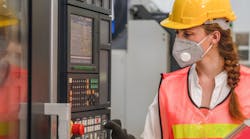April Jobs Report: Overall Economy Hires 428,000, Manufacturing Adds 55,000
Despite persistent reports of a tight hiring market, U.S. manufacturing firms hired a healthy 55,000 more workers in April, up from 43,000 hired in March. The strong employment gains for manufacturing fit in with the rest of the economy, which added 428,000 new hires last month. Despite those gains, the unemployment rate remained stable at 3.6%.
Notable gains in manufacturing hiring took place in transportation equipment, food manufacturing, and machinery. The transportation equipment sector added an estimated total of 13,700 jobs, about half of which—6,100—were in motor vehicles and parts production. Machinery production added 7,400 jobs, and wood products, fabricated metal products and computer and electronic products also each added at least 3,000 new jobs.
Food manufacturing, the largest segment in nondurable manufacturing, took in 7,900 more workers, while the plastics and rubber manufacturers added 5,700 more workers.
The latest figures show manufacturers pumping the breaks on wage increases. After increasing by 15 cents an hour between February and March, the average hourly wage in manufacturing rose only half that—7 cents—between March and April. It is now $24.78 an hour.
Durable goods manufacturing wages specifically rose 11 cents to $25.94 an hour after rising 21 cents an hour in March, and nondurable goods wages remained unchanged at $22.91 an hour.
By comparison, average wages in the total private economy grew 7 cents in March to $27.02, then 10 more cents an hour in April to $27.12.
Secretary of Labor Marty Walsh, in a statement, said the report is a positive sign that the hiring market has recovered substantially from the pandemic.
“Ninety-five percent of the jobs lost to the pandemic are now recovered, insured unemployment is at a historically low level, and labor market disruptions due to COVID-19 are at all-time lows,” he said. The latest numbers from the Department of Labor, released May 5, show that the insured unemployment is currently 1%.
Walsh's 95% figure holds true for manufacturing. The latest figures for manufacturing show the sector as only 0.4% or 56,000 employees smaller than it was before the COVID-19 pandemic affected employment numbers in March 2020.




